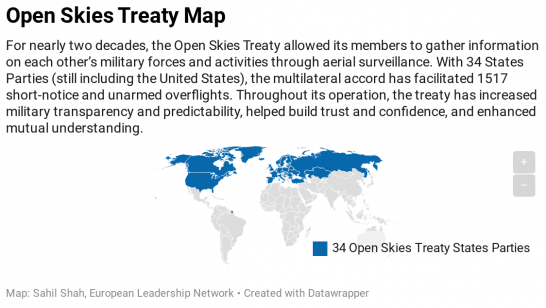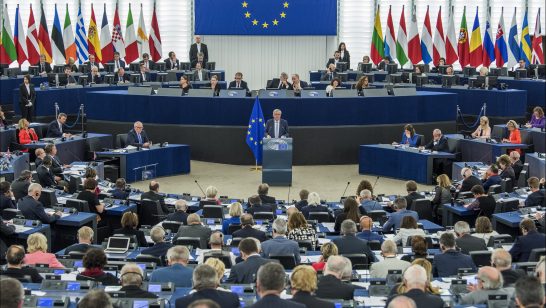
This week the Kremlin put a bill to the Lower House of Parliament to withdraw from the Open Skies Treaty, following the US’s departure in November, despite the treaty’s benefits for security in wider Europe. Moscow’s withdrawal would leave the entire agreement all but worthless. The OST was the last functioning part of the conventional arms control regime between the US and Russia, which has become increasingly unstable. The further erosion of this regime creates dangerous gaps in transparency as well as confidence and security building measures (CSBM). Most dramatically for Europeans, the looming demise of the OST highlights once again their limited influence when it comes to creating and sustaining arms control. As long as Europe does not find a powerful voice, its security will remain a side effect of US-Russia relations
Konstantin Gavrilov, Head of the Russian arms control delegation in Vienna, had said in April that the internal procedures preparing for a withdrawal may be completed by the end of May unless there was a “clear and unambiguous message” from the US about their decision to return to the OS community.
In contrast to his earlier vocal support for the agreement, President Biden has apparently closed the door on OST. The treaty was apparently mentioned in the Biden-Putin call in January before the extension of New START, but not in the recent one in April. While there was a legal debate in the US at the beginning of the year about the possibility of rejoining, the State Department told multiple partners in a démarche on 31 March that “agreeing to rejoin a treaty that Russia continues to violate would send the wrong message to Russia”, according to Defense News. A final decision has yet to be made, but there is no indication that the administration will revise this particular legacy of the Trump era. Indeed, on April 3 the US Air Force announced the retirement of the US OS aircraft. These two planes, the OC-135B, were outdated observation planes, but sending them to the scrapyard before there is a final decision on the US’ return sends a strong signal about the direction of thinking in the US.
One can assume that the OST is rapidly moving towards becoming a formally existing but non-functional agreement similar to the Conventional Forces in Europe treaty (CFE) and the Vienna Document (VD). Both agreements are considered crucial for security in wider Europe, but states parties have failed to carry out modernization (VD) or implement adaptation (CFE), even though the need to safeguard European security is becoming more and more apparent.
The OST might lose another member as an immediate consequence of Russia’s withdrawal: Belarus, which forms a treaty union with Russia and does not operate an independent observation aircraft. The remaining 31 states parties might see value in keeping the treaty alive in order to preserve the possibility to conduct extraordinary observation flights in times of crisis, as a conflict prevention/monitoring measure. In the past, this option has been used by Kiev in 2014 and by the US during the Russian attack on Ukrainian naval vessels in the Kerch Strait in 2018.
However, the main purpose of the treaty as a confidence-building measure between the West and Russia will be gone. This comes in a broader context where military-to-military contacts between NATO and Russia are in abeyance, and have been since the illegal seizure of Crimea, which deprives Europe of an important de-escalatory tool.
The OST will not bust with a big bang. Its unspectacular demise, however, will further destabilize European security. It continues the worrying trend of the abrogation of other arms control agreements like the Anti-Ballistic Missile Treaty (ABM), the CFE and the Intermediate-range Nuclear Forces treaty (INF).
The fate of the OST says a lot about the current state of Europe. It is noteworthy that although OST was designed as a confidence and security building measure in the interests of Europe as much as Russia and the US, its unraveling has little to do with Europe, and almost exclusively reflects US-Russia relations. Russia has blatantly showcased its disregard of European states as equal partners. At first sight, Moscow’s concerns over the possible sharing of OS data with the US puts the legal text into question, but more profoundly, it degrades NATO members of the OST to being no more than America’s extended arm. Biden, on the other hand, has promised to re-establish transatlantic ties, yet is unwilling to readjust the message he wants to send to Russia, even if this comes at the expense of European security. Although both cases are very different, their commonality is that they make Europe a side-stage in great-power rivalry.
Of course, this could only happen because Europeans are willing to accept the status quo, be it out of complacency or perceived powerlessness. With regards to the fate of the OST, a decisive and concerted European answer would have been crucial to safeguard the regime (without ceasing to hold Moscow responsible for its violations of the treaty). European leaders might have tried to voice their interests, but they have not been able to effectively identify a way to deal with Russia’s provocative behavior in the meetings of the Open Skies Consultative Commission (OSCC). Apart from a letter sent by 16 foreign ministers to Lavrov, Europe has been strikingly silent and, as a German official put it in a private conversation, “waited patiently”. It is very telling that even the Green party in Germany has recently started debating “Machtpolitik” (power politics), mindful of Europe’s disadvantageous place in a world increasingly dominated by multipolarity. ‘Waiting patiently’ in that sense thwarts the often-claimed expectation for Europe to speak a language of power.
Today, the Euro-Atlantic region faces a blank slate of arms control. This is a dramatic development, but it also offers the opportunity to create a new arms control regime ‘from scratch’. If Europeans want to benefit from a new round of arms control talks, probably leading to a regime that also includes emerging technologies and other actors like China, they must energize exchange between European capitals on arms control and deterrence. They must develop a united and strong stance on precisely the questions that are the most controversial ones, such as the role of the French nuclear deterrent for European security, and the future value of nuclear sharing. Here, divergent views among key actors like for example France, Germany, and Poland play a key role and have to be addressed constructively.
European members in the EU and NATO have already acknowledged the fundamental problem and are on their way to identifying convergences and divergences through efforts like the Strategic Compass and the NATO 2030 report. To make these ambitious projects meaningful, they should be complemented by additional steps, including a clear emphasis on the central importance of arms control in the conclusions of the upcoming NATO summit in June. European leaders should further strive for a strong commitment to arms control and risk reduction in NATO’s new Strategic Concept. If they fail to do their homework now, they will be unable to break a vicious circle in which European security is a byproduct of US-Russia relations.
The opinions articulated above represent the views of the author, and do not necessarily reflect the position of the European Leadership Network (ELN) or any of the ELN’s members. The ELN’s aim is to encourage debates that will help develop Europe’s capacity to address pressing foreign, defence, and security challenges.
Image: Flickr, José Luis Celada Euba



